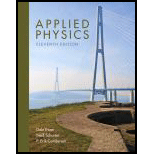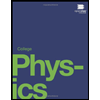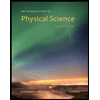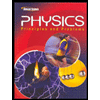
The atomic particle that carries a positive charge is
- a. the neutron.
- b. the proton.
- c. the electron.
- d. none cf the above.
Find the correct option.
Answer to Problem 1RQ
The correct option is “b. proton”.
Explanation of Solution
The atomic particles inside an atom are in stable condition since the equal number of charges balance each other, that is, the quantity of protons and electrons are the same. The protons carry a positive charge and the electrons carry a negative charge that stabilizes the atom.
Therefore, option b is correct.
Since neutron and electron has a neutral charge and negative charge respectively, option a and c are wrong.
As one of the above options, b is the correct the answer, it cannot be none of these. Therefore, option d is wrong.
Conclusion:
Thus, the correct option is “b. proton”.
Want to see more full solutions like this?
Chapter 17 Solutions
Applied Physics (11th Edition)
Additional Science Textbook Solutions
Life in the Universe (4th Edition)
College Physics: A Strategic Approach (3rd Edition)
Lecture- Tutorials for Introductory Astronomy
Essential University Physics: Volume 1 (3rd Edition)
The Cosmic Perspective (8th Edition)
College Physics: A Strategic Approach (4th Edition)
- A certain five cent coin contains 5.00 g of nickel. What fraction of the nickel atoms’ electrons, removed and placed 1.00 m above it, would support the weight of this coin? The atomic mass of nickel is 53.7, and each nickel atom contains 28 electrons and 28 protonsarrow_forwardAre you relatively safe from lightning inside an automobile? Give two reasons.arrow_forwardWhat are the signs of the charges on the particles in Figure 22.46?arrow_forward
- What net charge would you place on a 100 g piece of sulfur if you put an extra electron on 1 in 1012 of its atoms? (Sulfur has an atomic mass of 32.1.)arrow_forwardWhy do most objects tend to contain nearly equal numbers of positive and negative charges?arrow_forward1. Two charged objects have a repulsive force of 0.8 N. If the Charge of one of the objects is doubled then what is the new force? 2. Two charged objects have a repulsive force of 0.8 N. If the charge of both objects is doubled, then what is the new force?arrow_forward
- electrons are in the ____ of an atom . a) center b) outside plastic and rubber do not ____ - an electrical circuit . A(n) ______ is an object that allows some electrons to go through it. the amount of volts and amps is the number of _________arrow_forward8. What is IDS ?arrow_forwardHow many electrons make up a charge of -50.0 μC ? Express your answer using three significant figures.arrow_forward
- A lab creates a new element named Elementy McFacium. The element is created ionized with 182 protons and 180 electrons. The nucleus also holds 226 neutrons. What is the change of the ion? (Answer in multiples of the fundamental charge)arrow_forward29 . What is the electric field acting on a 2.0C charge if an electro static force of 10500 N acts on the particlearrow_forward6. A balloon with a charge of 4.0 µC is held a distance of 0.70 m from a second balloon having the same charge. Calculate the magnitude of the repulsive force. 7. At what distance of separation must two 1.00-microCoulomb charges be positioned in order for the repulsive force between them to be equivalent to the weight (on Earth) of a 1.00-kg mass?arrow_forward
 College PhysicsPhysicsISBN:9781938168000Author:Paul Peter Urone, Roger HinrichsPublisher:OpenStax College
College PhysicsPhysicsISBN:9781938168000Author:Paul Peter Urone, Roger HinrichsPublisher:OpenStax College An Introduction to Physical SciencePhysicsISBN:9781305079137Author:James Shipman, Jerry D. Wilson, Charles A. Higgins, Omar TorresPublisher:Cengage Learning
An Introduction to Physical SciencePhysicsISBN:9781305079137Author:James Shipman, Jerry D. Wilson, Charles A. Higgins, Omar TorresPublisher:Cengage Learning Glencoe Physics: Principles and Problems, Student...PhysicsISBN:9780078807213Author:Paul W. ZitzewitzPublisher:Glencoe/McGraw-Hill
Glencoe Physics: Principles and Problems, Student...PhysicsISBN:9780078807213Author:Paul W. ZitzewitzPublisher:Glencoe/McGraw-Hill


